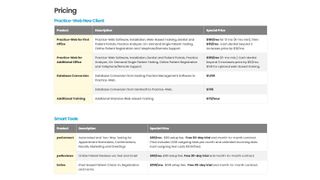TechRadar Verdict
Practice-Web has useful features by the truckload, but the pricing is confusing, and some essentials, like e-Prescribing, are an added cost extra.
Pros
- +
Multiple support options
- +
Transparent pricing
- +
3D tooth charting
- +
Supports electronic patient registration
Cons
- -
Limited hours of support
- -
Lacks free trial
- -
No mobile apps
- -
Graphical interface is dated
Why you can trust TechRadar
Practice-Web was founded in 1990, and based in El Dorado Hills, California. While at its core, the focus of Practice-Web is dental practice management, and clinical care for a full variety of dental specialties, it also encompasses all the tools for a paperless office, has social media aspects, and has bridges to over sixty third-party systems, and over a dozen billing clearinghouses.
Features
Practice-Web makes the bold claim that it can enable a practice to go completely paperless. This is too often a pipe dream for many practices, that find themselves printing out stuff constantly, with the costs of a printer and the consumables. With Practice-Web, the dental office can be truly paperless, with a streamlined workflow. Charting for visits can become fully electronic, which also translates to online billing- both paperless. Furthermore, traditional paper processes like patient registration with form completion can also be done fully electronic. Even those patient recall postcards can be replaced with two-way texting. Finally, the drudgery of mailing out invoices for billing is also more efficient when done via a pay-by-text process.
This automated texting process also yields benefits for scheduling. Practice-Web has a fully automated and electronic scheduling process, making it easy to enter and track appointments. The integrated two-way texting also reduces the dreaded no-shows that create scheduling problems, that then cost a practice revenue.

The electronic charting uses an innovative feature known as 3D tooth charting. This makes it easy to not only chart the work completed, but also to create treatment plans for upcoming procedures. This then makes it simple for submission to insurance companies for preapproval, and for patients to sign off on- and translate into a higher likelihood of getting paid in a timely fashion as the work gets done.
The hallmark of an effective dental practice management solution is not only that it supports the dentist, but also that the entire team is kept in sync, towards the common goal. Practice-Web features multiple tools to keep the team together, such as interoffice messaging and operatory alerts. Tasks can also be assigned efficiently to the appropriate team member, with detailed tasks lists, that can then be tracked for completion. Management of other office based tasks can also be done, such as the time cards for employees, along with their schedules, and statuses.
Drawbacks
A notable drawback is the total lack of mobile app support. Many folks appreciate access to the data while on the move, such as when on call, but Practice-Web does not support neither an Android, nor an iOS app.
Going through user reviews, we find shortcomings with initial training, and also a dated graphical interface that could be modernized. Another user encountered a problem with the texting application, although it was also stated that support was able to help them.
We also point out that while there is a free demo, there is no free trial for a better assessment of the software prior to a commitment.

Pricing
While we frequently ding software providers for their opaque pricing, dental practice management is quite transparent. Truthfully, it might be a little too transparent, with a dizzying array of add ons to the plans, and then a long menu of additional options that are sure to confuse many users as to what should be purchased.
The basic Practice-Web plan is easy enough, although it is a little puzzling (unlike most introductory offerings from cable companies that start cheaper), that the initial charge is higher at $149 (£120) per month, and then drops to $109 (£88) monthly after the initial 12 months. Additional offices are $99 (£80) per month, and dentists above three in the practice cost an affordable $10 (£8) monthly. Startup costs also escalate as the conversion cost from another provider is a hefty $995 (£800).
Unfortunately, there are also a gaggle of extras that push up the cost. These include PatientEnroll, an iPad automated check in module for $69 (£55) monthly, pwConnect, automated texting for appointments and such that starts at $69 (£55) monthly for SMS, and pwReviews, that for the same price can manage online patient reviews, each also has a $99 (£79) setup fee, and bundle packages are available. As if this was not enough, there are additional costs for e-Prescribing, patient payment plans, and Smart Caller ID among the offerings.
Final verdict
When it comes to running a busy dental practice, Practice-Web brings plenty of excellent features. The highs include a choice of support options, 3D tooth charting for treatment planning, and electronic registration. The lows range from a lack of mobile apps, the overflow of pricing options with an additional cost to e-Prescribe, and the lack of an available free trial. In the final analysis, Practice-Web is a decent, middle of the road option, balancing a fair value for the price offered.
- We've also highlighted the best dental practice management software
Jonas P. DeMuro is a freelance reviewer covering wireless networking hardware.


